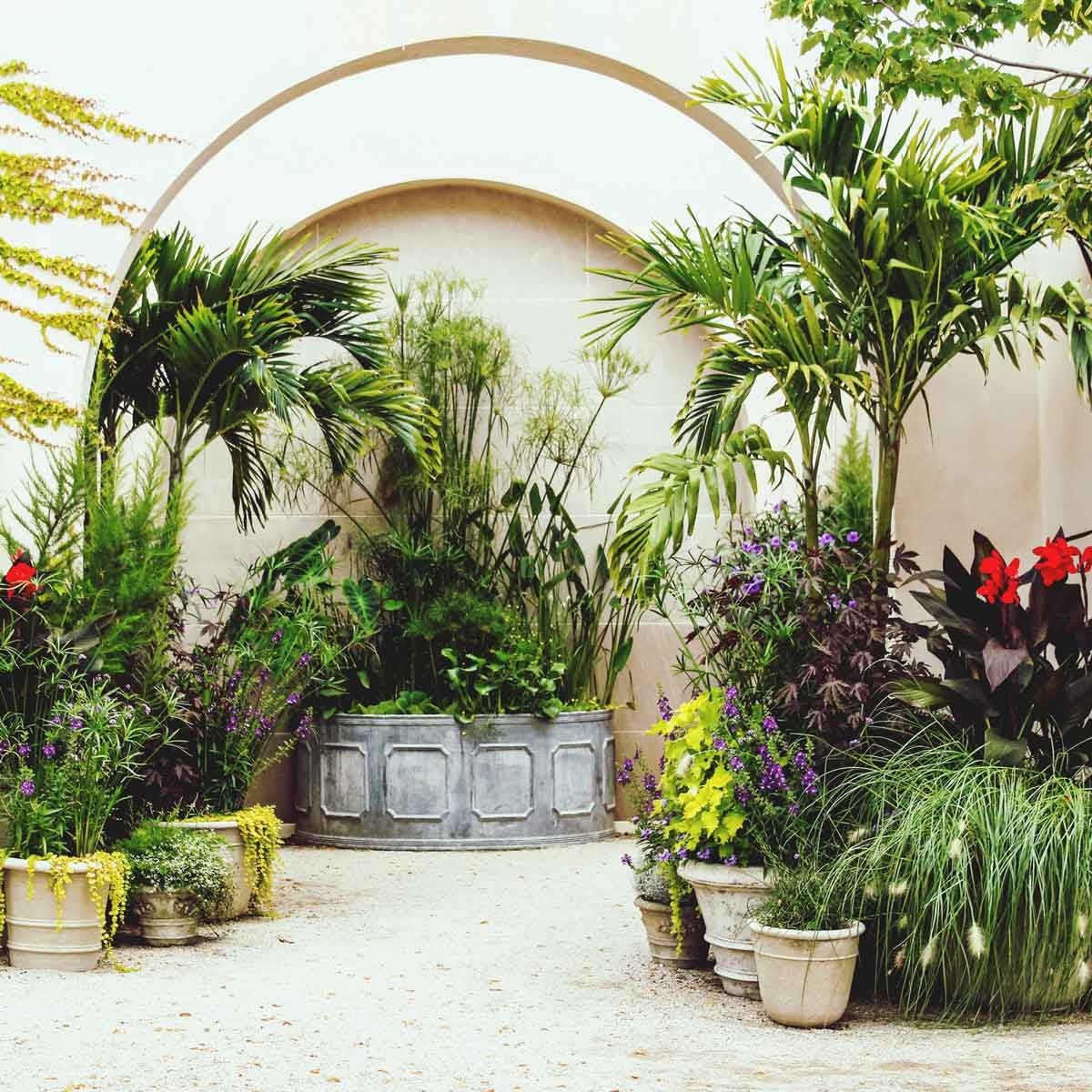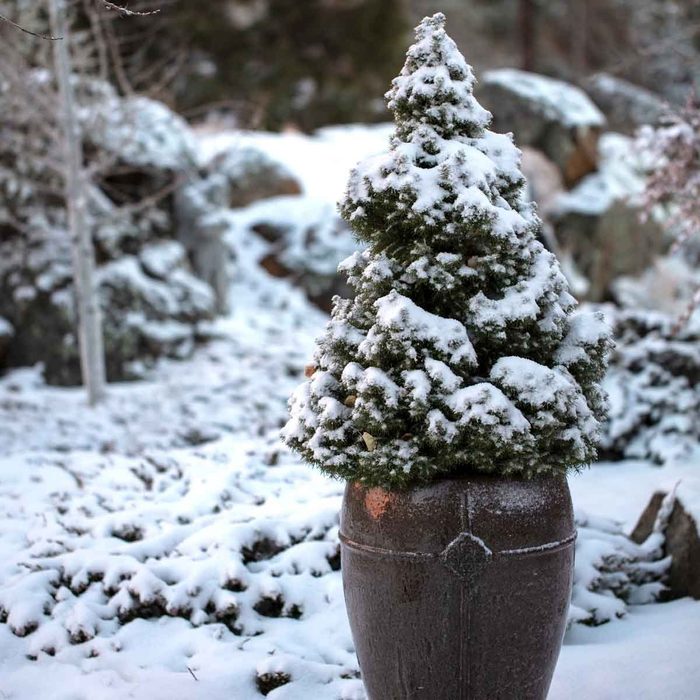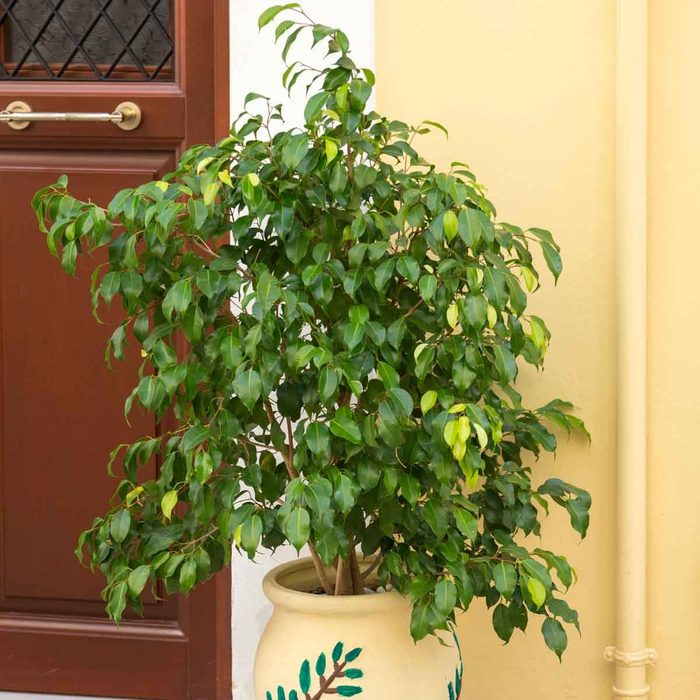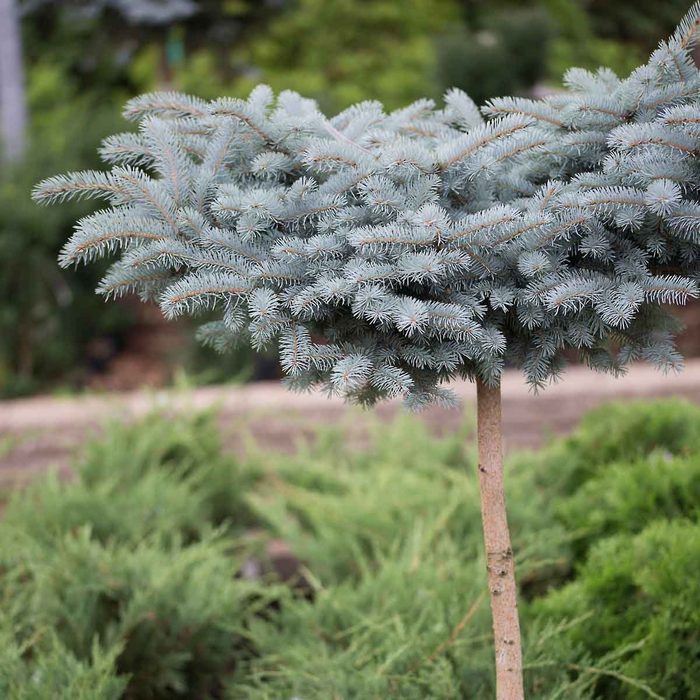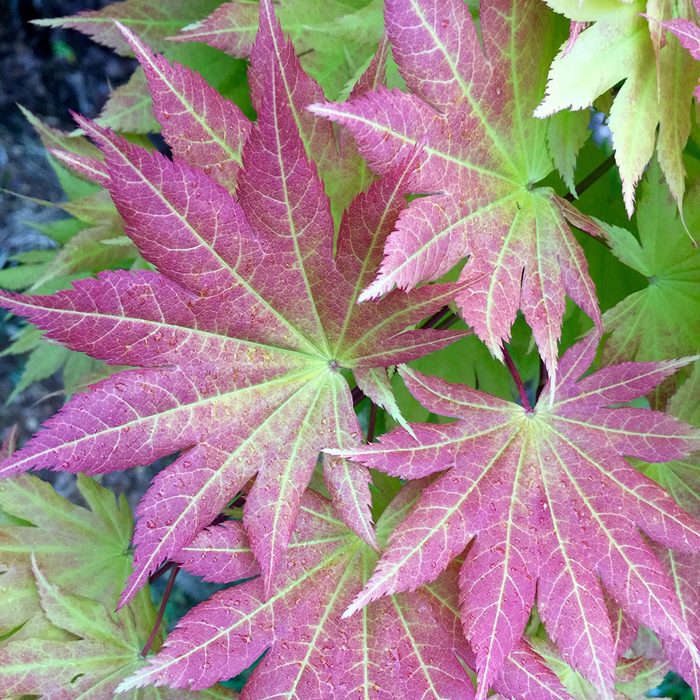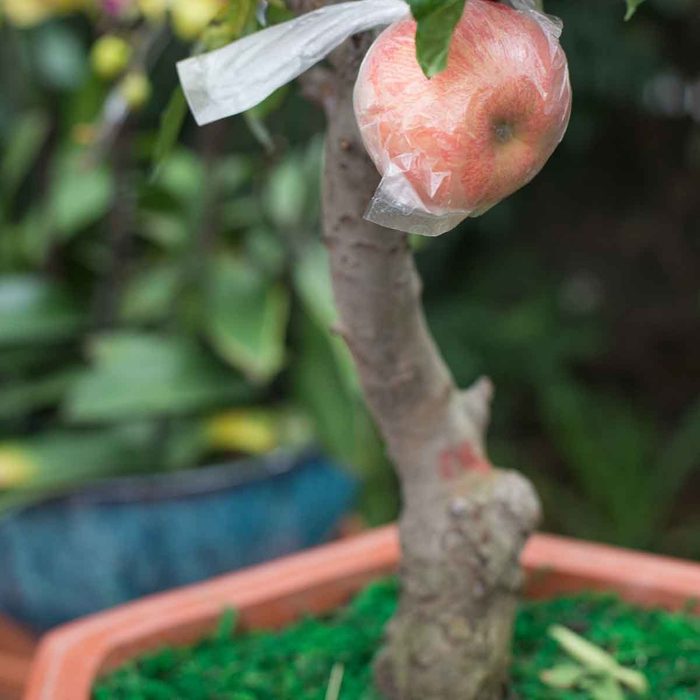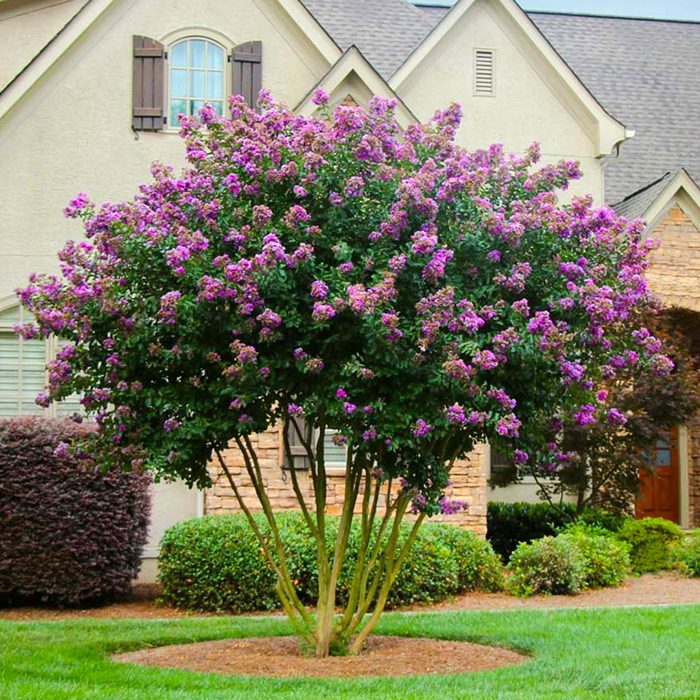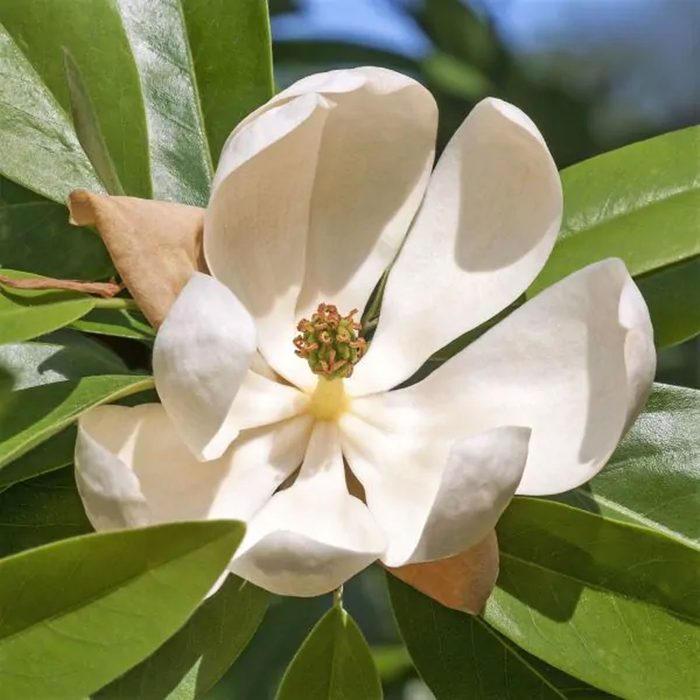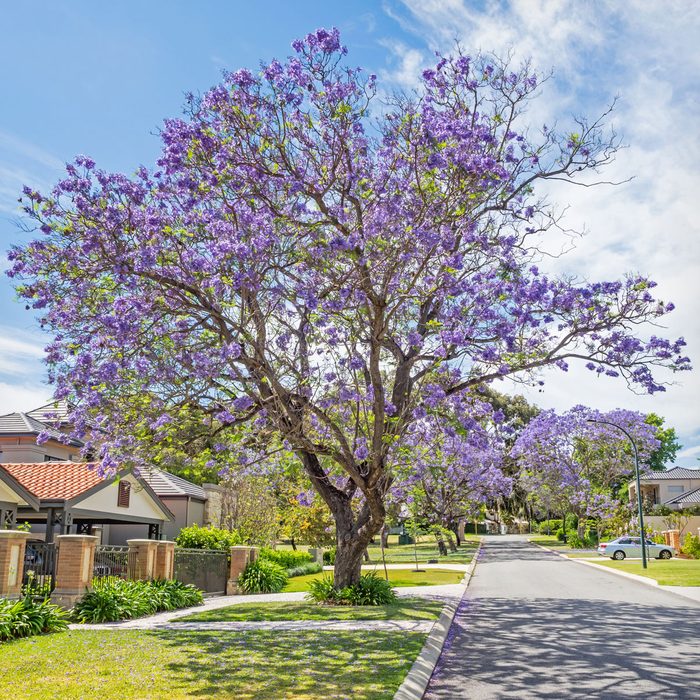MALISA NICOLAU/GETTY IMAGES
Pros:
-
Grows slowly
-
Can withstand cold temperatures
-
Stays small
-
Maintains its shape
-
Does not need pruning
With an attractive conical shape and compact size, dwarf Alberta spruce (Picea glauca ‘Conica’) has developed quite a following. You’ll even see it offered in late fall as a miniature Christmas tree. Dwarf Alberta spruce grow only two to three inches a year, topping out at about eight feet. Cultivars of this dwarf conifer are available with green or blue-gray needles. It is hardy in U.S. Department of Agriculture plant hardiness zones 2 to 8.
Pros:
-
Dense green leaves
-
Resilient and low maintenance
-
Can be scuplted into different shapes
-
Thrives indoors and outdoors
Cons:
-
Needs fertilizer once per month
-
Can grow to 10 ft. tall
This tropical native is a beloved houseplant. Weeping fig (Ficus benjamina) can grow up to 60 feet tall outdoors in tropical climates, yet they are well suited to container growing. Homeowners can easily grow six-foot-tall ficus by limiting the pot size and doing occasional pruning. Ficus like bright, indirect light and actually perk up if they vacation outdoors in the protected high shade of a tall tree. Bear in mind they often drop leaves if their lighting situation changes, but quickly recover.
Pros:
-
Can fit well into small spaces
-
Evergreen
-
Unique silvery-blue color
-
Can withstand frigid weather
-
Drought-tolerant
Cons:
-
Can grow to 25 ft.
-
Requires a lot of sunlight
It’s tough and hardy like its parent, but Picea pungens ‘Globosa’ has a much more modest size — three to five feet tall compared to 50 feet or more for the larger. It’s also slow growing, putting on only a few inches a year, so it’s suitable for containers as well as small entryway gardens. While some ‘Globosa’ are sold as rounded shrubs, there is a topiary version that looks particularly stunning in a pot. This variety has blue-gray foliage that looks nice against a base of neon-pink petunias. It is hardy in USDA zones 2 to 8.
JOHNER IMAGES/GETTY IMAGES
Pros:
-
Beautiful, bright red leaves
-
Leaves stay bright longer than the average tree
-
Low maintenance
-
Does not require pruning
Cons:
-
Color fades in high heat conditions
-
Requires a lot of sunlight
Breeders have made sure that anyone, no matter how small their yard, can enjoy a tree like the Japanese maple (Acer palmatum). While some cultivars reach 25 feet over many years, others grow just two or three feet tall. These trees feature attractive mounded, vaselike or cascading shapes. There’s also a variety of foliage selections, including green, variegated and burgundy — in a choice of palm-shaped or highly dissected leaves. Most Japanese maples are hardy in USDA zones 6 to 8 but some accept zone 5. Where winter temperatures are a concern, shelter from cold wind helps. Also, potted trees can be taken inside in winter.
Pros:
-
Heat tolerant
-
Beautiful red and orange leaves
-
Stays relatively small
-
Grows slowly
Cons:
-
Only drought tolerant once established
Full Moon maple (Acer shirasawanum) is a Japanese native grown for its attractive palm-shaped leaves and beautiful fall color. The slow-growing species can eventually reach 15 to 20 feet tall, but cultivars such as ‘Autumn Moon’ are smaller and better suited to container growing. ‘Autumn Moon’ slowly reaches eight to 12 feet. The tree features colorful chartreuse foliage with orange and salmon undertones that eventually turn hues of gold or red in fall. It is hardy in USDA zones 5 to 7.
Pros:
-
Attracts pollinators
-
Can grow large, producing many apples
-
Low chill requirement
-
Blooms in the summer
Cons:
-
Needs highly acidic soil
-
Requires full sun
Imagine your own mini orchard! And you don’t need a farm if you’re growing potted apple trees (Malus spp.). Many apple varieties are available in dwarf form, some even as columnar trees that take up very little space. You’ll need two for cross-pollination or a crabapple tree nearby. And while you may start with a five-gallon specimen, you will need to upsize the container every few years until you get to about a 15-gallon size. Miniature apple trees are hardy in USDA zones 4 or 5 to 7 or 8, depending on cultivar.
Pros:
-
Stunning, bright blooms
-
Highly drought tolerant
-
Low maintenance
-
Fragrant flowers
Cons:
-
Grows very quickly, so may outgrow its pot fast
This Southern staple can be grown in the North when it’s pot-grown and can be taken to shelter in winter. Normally hardy in USDA zones 7 to 10, crape myrtle (Lagerstroemia indica) grows 25 to 30 feet in the Southern landscape. Smaller varieties are just three or four feet tall and can be raised in large containers. That’s great news, because it means everyone can enjoy a bright summer flower show. Flowers include a choice of red, pink, white, lavender and fuchsia blooms, depending on cultivar.
Pros:
-
Bright, fresh white flowers
-
Fragrant
-
Adaptabe and low maintenance
-
Can be planted near houses
Cons:
-
Cold climates cause leaves to fall off in the fall and winter
This broadleaf evergreen has a slender, conical form and highly aromatic foliage. That, along with its slow growth rate and drought tolerance, makes it a fine potted tree. Sweet bay (Laurus nobilis) can also be clipped into formal or topiary shapes, which is why you’ll often see matching specimens adorning either side of a formal doorway. It is hardy in USDA zones 8 to 11.
ZAMBEZISHARK/GETTY IMAGES
Pros:
-
Bright, blue and purple flowers
-
Thrives indoors or outdoors
-
Can be grown in most types of soil
-
Low maintenance
Cons:
-
Can grow up to 40 feet tall
Anyone who’s ever been enchanted by the large jacaranda trees lining California boulevards will never forget the sight. These large, showy deep-purple blooms are also available on dwarf plants, such as Bonsai Blue (Jacaranda mimosifolia ‘Sakai01’). While a landscape jacaranda tree can reach 50 feet, Bonsai Blue is just 10 to 12 feet tall. Although it grows fast, you can keep it shorter because the attractive fernlike foliage takes pruning in stride. It’s also drought tolerant — a definite plus when it comes to container plants. Bonsai Blue jacaranda is hardy in USDA zones 9 to 11.
How to Grow a Tree in a Pot
It’s easy to grow a tree in a container if you follow a few simple steps.
- Select a dwarf variety (they’re better suited to containers and won’t require as much pruning) or a tree form shrub, which is pruned into a single trunk.
- Use a large container. It aids tree growth, allowing for a bigger root mass that better withstands erratic watering.
- Fill the container with a potting mix containing moisture-retentive crystals to capture more irrigation water.
- Water regularly. A pot-grown tree needs more frequent watering than one planted in the ground.
- Winter protection is needed in cold climates. Store dormant deciduous trees in an attached garage, keeping the rootball slightly moist. Return it outdoors in spring. Evergreens still need light in winter, so it’s best to “heel in” a potted evergreen unless the garage has a window. This means temporarily burying the tree’s roots in the ground for the winter and mulching heavily. Return the tree to its pot in spring.
What To Look For When Shopping For Trees To Grow In a Pot
You may think of trees as plants that grow strictly in the ground, but several varieties of trees can grow and thrive in pots. Consider slow-growing and adaptable varieties when searching for a tree to grow in a pot. Fast-growing trees might thrive, but they’d need to be repotted often, which, though doable, requires more maintenance than slow-growing varieties. Consider the weather conditions in your area and choose a tree that is well-suited to your climate. For example, some trees may not fare as well in very hot weather, whereas others may not thrive in the cold. Furthermore, choose one that draws your eye visually. Trees grow to be large, so choosing one that you find beautiful and complements your yard or home is important.
Why You Should Trust Us
Luke Miller is a garden editor with over 25 years of experience in horticultural communications. Miller has edited a national magazine and created print and online gardening content for a national retailer. Additionally, he is a Master Gardener and has extensively studied horticulture.
Nina Derwin is a commerce updates editor for Family Handyman. She has experience researching and reviewing various items to help shoppers find the best products on the market. She researched and updated this piece.
How We Found the Best Trees to Grow In a Pot
When considering the best trees to grow in a pot, we first considered size. We searched for sturdy varieties that can withstand all types of weather conditions, including hot sun and chilly winter temperatures. We also paid close attention to the appearance of different types of trees and their aesthetic qualities, both indoors and outdoors.
FAQ
Can trees survive in pots?
When watered and properly fertilized, potted trees can survive for many years. Be sure to use a large enough container to allow the tree room to grow. You may need to transfer it to a larger container over time.
What size pot do I need for a five foot tree?
Generally, a five-gallon container is the correct size for a four- to five-foot tree. The dimensions should be approximately 12 inches by 12 inches. For a five- to seven-foot tree, consider using a seven-gallon or 14-inch by 14-inch container.
How deep should I plant a tree in a pot?
When digging a hole in soil to plant a tree in a pot, the hole should not be deeper than the tree’s root ball. It’s important that the root ball rests on the soil in the center of the container.
ⓘ




















